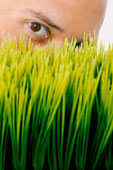 Does the new breed of 'superfoods' only come from exotic, faraway lands?
Does the new breed of 'superfoods' only come from exotic, faraway lands?
Louise Ellis investigates
Nutrient packed superfoods are the new buzzword for anyone looking to get that bit healthier. Whether it is the supermarket chains slinging a few whole grains from South America into a salad, or drinks manufacturers adding exotic sounding berries from Tibet into a carton of juice, it seems that everyone is clamouring to get on the superfoods bandwagon.
However, it is an oft quoted truism that the things that we really need for our life are to be found in our own backyard. So it might not be surprising to find out that the shot of high energy wheatgrass juice available now in most juice bars around the country is in fact the same as the turf which we walk across every day. And amazingly, this very same grass is actually one of the most powerful types of food to be found on this planet.
But when you think about it, this concept begins to make sense. Why else would sheep and cattle spend all day chomping away on grass out in the fields and mountains? What is it that they metabolise into high quality steaks and cutlets which end up on our dinner tables? Quite simply, they live on grass.
Over the past few years wheatgrass has become increasingly popular as a superfood. But not many people actually know its story and how it was “discovered”. I first heard about wheatgrass juice back in 2003. I was living in
 The late Dr Ann Wigmore, a pioneering health visionary, first brought the healing powers of grasses to the attention of the general public during the 1950s and 60s. As a child growing up in a village in
The late Dr Ann Wigmore, a pioneering health visionary, first brought the healing powers of grasses to the attention of the general public during the 1950s and 60s. As a child growing up in a village in
Moving to the
She sent different types of grass for laboratory analysis, discovering that wheatgrass is an exceptionally concentrated source of vitamins, minerals, all essential amino acids, trace elements, enzymes, DNA and RNA, and chlorophyll. She also read the work of other scientists and in her book, The Wheatgrass Book, she quotes the findings of Dr Charles Schnabel, who estimated that “15lbs of wheatgrass is equal in protein and overall nutritional value to 350 lbs of ordinary garden vegetables.” (The Wheatgrass Book, Ann Wigmore, p. xii, Penguin Putnam)

While fruit is beneficial, another point highlighted by Dr Wigmore is that dark green leafy vegetables are full of chlorophyll, which converts sunlight into energy. It has high mineral and protein content, and has a virtually identical molecular composition to human blood. She describes one of the health values of chlorophyll, as being “condensed solar energy”.
She explains, 'The leaves of plants convert sunlight into energy that is stored in the plant fibres. People who have the habit of eating meat or drinking milk are merely getting this solar energy second-hand, after the cow has converted it into milk or flesh. Seventy percent of the solid matter in wheatgrass juice is crude chlorophyll. In wheatgrass (and in uncooked fresh vegetables, sprouts and greens), you can get 'concentrated sun power' firsthand' (The Wheatgrass Book, Ann Wigmore, p. 11, Penguin Putnam).
The list of health benefits which are claimed to arise from this high energy and nutrient food is long, but essentially derives firstly from its high alkaline content. This has a detoxifying and cleansing power, which eliminates toxins accumulated from everyday life, including the effects of pollution, household chemicals, stress, mass produced and processed foods. The high pH levels also prevents the metabolism of carcinogens, and growth of other pathogens, bacteria and fungi within the body.
Another reported effect of the chlorophyll is that it strengthens red blood cells, increasing oxygen absorption, and improving blood circulation. The high vitamin, mineral, amino acid and enzyme levels work alongside the cleansing processes, rebuilding the body’s resources and boosting the immune system.
 During my stay at the Ann Wigmore Institute I heard many stories of people being cured of a range of degenerative diseases, including cancer and heart problems, through taking wheatgrass juice. I also heard about its power as a general health tonic, strengthening bones, teeth and hair, improving skin tone, and increasing vitality. There were also claims that the high enzyme content could actually reverse many of the degenerative signs of ageing, such as baldness and grey hair. And last, but not least, wheatgrass also boosts the sex hormones, so it can give abit of added zest to your love life.
During my stay at the Ann Wigmore Institute I heard many stories of people being cured of a range of degenerative diseases, including cancer and heart problems, through taking wheatgrass juice. I also heard about its power as a general health tonic, strengthening bones, teeth and hair, improving skin tone, and increasing vitality. There were also claims that the high enzyme content could actually reverse many of the degenerative signs of ageing, such as baldness and grey hair. And last, but not least, wheatgrass also boosts the sex hormones, so it can give abit of added zest to your love life.
A number of companies are now marketing dried wheatgrass power, with the obvious benefit of being a convenient way to consume it on a daily basis. However, experts say that a significant proportion of its nutritional value will have been lost in the drying process. Lalita Salas, director of the Ann Wigmore Institute, explained that the nutrients in wheatgrass begin to break down very soon after it is juiced and exposed to the air. It should be used as soon as possible after being juiced.
Wheatgrass is very inexpensive and simple to grow, even in a small
Dr Wigmore’s philosophy comes with a strong environmental message, that we live in a community on this earth with all other living beings. Growing your own food leaves a light environmental footprint, so it’s good for our ailing planet, as well as helping to improve our own health. Even within the confines of my
